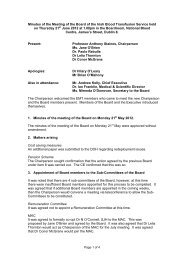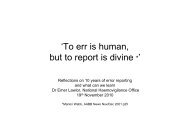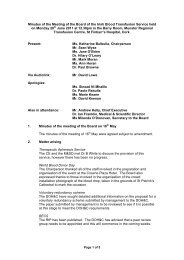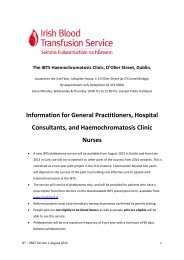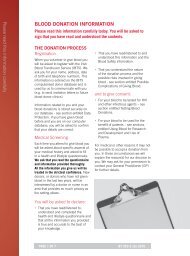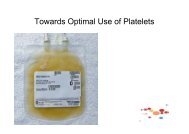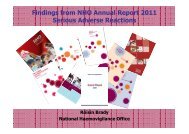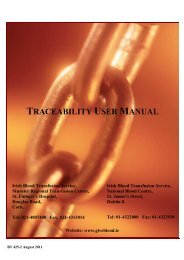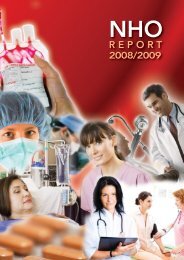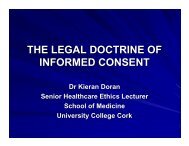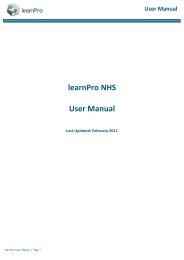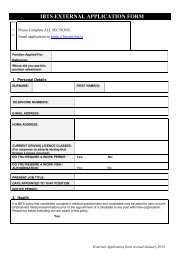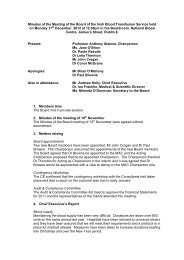IBTS Annual Report 2007.pdf - Irish Blood Transfusion Service
IBTS Annual Report 2007.pdf - Irish Blood Transfusion Service
IBTS Annual Report 2007.pdf - Irish Blood Transfusion Service
Create successful ePaper yourself
Turn your PDF publications into a flip-book with our unique Google optimized e-Paper software.
<strong>Annual</strong> <strong>Report</strong> 2007
o u r m i s s i o n s tat e m e n t<br />
“The <strong>IBTS</strong> is committed<br />
to excellence in meeting<br />
patients’ needs through the<br />
professionalism of our staff<br />
and the generosity of our<br />
donors.”
Contents<br />
Our Values<br />
Excellence in service<br />
We will achieve excellence in delivering<br />
a quality service to our patients and our<br />
donors<br />
Chairperson’s message 03<br />
Chief Executive’s <strong>Report</strong> 05<br />
National Medical Director’s <strong>Report</strong> 09<br />
Optimising use of the donor’s precious gift 13<br />
Operating in an environment of continuous change 19<br />
In pursuit of excellence 25<br />
Supporting best practice in patient care 27<br />
Implementing change and delivering efficiencies 33<br />
Finance 34<br />
Corporate Governance 37<br />
Contact Details 40<br />
Respect<br />
We will treat our donors, patients,<br />
colleagues and all others with whom we<br />
interact with consideration and respect<br />
Honesty<br />
We commit to honesty and openness in all<br />
our dealings.<br />
Learning<br />
We are committed to ongoing<br />
organisational learning, professional and<br />
personal development and research<br />
Accountability<br />
We will hold ourselves accountable to the<br />
highest professional, personal and public<br />
standards<br />
Team work<br />
We commit to working together in a<br />
positive and constructive manner<br />
<strong>Irish</strong> <strong>Blood</strong> <strong>Transfusion</strong> <strong>Service</strong>
2<br />
“The issue of safety is of<br />
paramount importance and<br />
every advance in screening<br />
and testing techniques is<br />
utilised.”<br />
<strong>Annual</strong> <strong>Report</strong> 2007
3<br />
Chairperson’s Message<br />
The primary reason why the <strong>IBTS</strong> exists<br />
is to provide world-class safe blood<br />
components in sufficient quantities as<br />
required by clinicians in our hospitals. We<br />
achieved this objective in 2007.<br />
I wish to express my appreciation to the<br />
dedication and effort of the staff of <strong>IBTS</strong><br />
throughout the year in the delivery of this<br />
most important national service.<br />
The issue of safety is of paramount<br />
importance and every advance in<br />
screening and testing techniques is<br />
utilised. However, the stringent application<br />
of ever advancing safety measures places<br />
ongoing pressure on donor supplies.<br />
The voluntary contribution of donors must<br />
not be taken for granted. Only 3% of our<br />
population are regular donors and this base<br />
must be expanded to ensure adequate<br />
supplies. We as a Board are committed<br />
to increasing public awareness of the<br />
importance and the magnificence of their<br />
contribution to the <strong>Irish</strong> health services.<br />
The manner in which we profile the <strong>IBTS</strong><br />
will become a major consideration for the<br />
Board in the months ahead. The unique<br />
generosity of our donors is acknowledged<br />
and deeply appreciated.<br />
The development of a new centre in Cork<br />
remains a priority for the Board and we<br />
await a decision from the Minster for<br />
Health and Children in this regard. I also<br />
wish to acknowledge the contribution and<br />
support of Board members during the past<br />
year.<br />
Maura McGrath<br />
Chairperson<br />
<strong>Irish</strong> <strong>Blood</strong> <strong>Transfusion</strong> <strong>Service</strong>
4<br />
“The most critical function<br />
of the <strong>IBTS</strong> is to maintain a<br />
consistent blood supply.”<br />
<strong>Annual</strong> <strong>Report</strong> 2007
5<br />
Chief Executive’s <strong>Report</strong><br />
I have pleasure in presenting the <strong>Annual</strong><br />
<strong>Report</strong> for the <strong>IBTS</strong> for 2007.<br />
The most critical function of the <strong>IBTS</strong> is to<br />
maintain a consistent blood supply. This<br />
is achieved through the generosity of our<br />
donors who give the gift of life to those who<br />
are ill, require elective surgery and suffer<br />
major trauma. For this we are eternally<br />
grateful.<br />
Like any other organisation the <strong>IBTS</strong> is not<br />
immune to changes in society both from<br />
the social perspective and the economic<br />
environment. The forecast for the <strong>Irish</strong><br />
economy is uncertain and could influence<br />
people’s willingness to donate. In these<br />
circumstances it is incumbent on the <strong>IBTS</strong><br />
to examine how we conduct our affairs to<br />
ensure that we are dealing with the most<br />
relevant issues, that we are cognisant of<br />
what is happening within our business<br />
across the globe and that we do this in the<br />
most effective and efficient manner.<br />
<strong>Blood</strong> Supply<br />
The <strong>IBTS</strong> were able to meet hospital<br />
requirements during 2007. This was<br />
achieved despite an increase of 1.16% in<br />
the use of red cells and an 8.7% increase<br />
in the use of platelets. We have seen a<br />
60% increase in the use of platelets over<br />
the past 5 years. In order to forecast future<br />
demand the <strong>IBTS</strong> will have to review the<br />
projected number of new cancer cases<br />
expected to arise in Ireland over the next<br />
decade and devise a strategy to deal with<br />
the resulting demand in platelets. It is<br />
clear that the current configuration of our<br />
platelets service will not be able to meet<br />
the expected treatment needs of patients.<br />
A Big Thank You to our selfless and<br />
committed donors and their families.<br />
Developments – Science and Technology<br />
There were a number of significant<br />
developments during the year which<br />
will enhance the service we provide to<br />
patients.<br />
The most important of these were:<br />
■■ Haemochromatosis Programme<br />
■■ Validation of single donor NAT on<br />
TIGRIS<br />
■■ Introduction of Orbisac for platelet<br />
production using Platelet Additive<br />
Solution rather than plasma<br />
■■ BOSS – just commenced at year<br />
end. This will provide much needed<br />
management information from Progesa<br />
in a timely manner<br />
It was planned that eProgesa would be<br />
live during 2007 but unfortunately due<br />
to a number of persistent difficulties the<br />
project was discontinued in March. This<br />
<strong>Irish</strong> <strong>Blood</strong> <strong>Transfusion</strong> <strong>Service</strong>
6<br />
necessitated re-visiting the current version<br />
of Progesa and in particular the hardware<br />
it was operating on. It was decided to<br />
stabilise the current version on new<br />
hardware. This project had commenced by<br />
year end with a scheduled completion date<br />
of March/April 2008.<br />
Quality<br />
One of the hallmarks of quality<br />
management systems is lots of paper<br />
moving around an organisation. In 2007<br />
we commenced the implementation<br />
of the Pilgrim Document Management<br />
System. This is a very significant project<br />
and will take approximately three years to<br />
implement fully. The first phase SmartDoc<br />
went live in October 2007 and will<br />
certainly make raising change orders and<br />
developing/amending SOPs much easier<br />
and have a positive affect on the forests.<br />
Organisation Development<br />
The biggest challenge facing the <strong>IBTS</strong><br />
over the immediate to medium term is<br />
implementing major change programmes<br />
affecting core areas of our business. This<br />
will involve consultation and negotiation<br />
with different trade unions. Fundamentally,<br />
there will also be a requirement to initiate<br />
cultural change so that a new order can<br />
be effected which will be conducive to<br />
implementing change.<br />
Significant change programmes are<br />
underway in the laboratories and donation<br />
clinics. When implemented successfully,<br />
these changes will improve the level of<br />
service to our donors and patients. Some<br />
progress has been achieved in 2007 but<br />
there will have to be significant progress<br />
made in 2008 if real change is to be<br />
realised.<br />
One important piece of work completed<br />
during 2007 was agreement on a set of<br />
values for the <strong>IBTS</strong>. These are Excellence<br />
in <strong>Service</strong>, Respect, Honesty, Teamwork,<br />
Learning and Accountability. The true<br />
worth of these will only be seen over time<br />
and real adherence will only happen if all<br />
staff practice these values in the course of<br />
their work. These must be embedded into<br />
the workings of the organisation and then<br />
must be measured to see how we are living<br />
them. This will be done through a survey<br />
over the next eighteen months.<br />
The <strong>IBTS</strong> has been organising training<br />
courses over the past number of years but<br />
these have been predominately focused<br />
on meeting technical requirements rather<br />
than on the personal development of staff.<br />
We have tendered for a major training and<br />
development programme which will reach<br />
<strong>Annual</strong> <strong>Report</strong> 2007
7<br />
across all sections of the organisation<br />
and is designed to delivering appropriate<br />
management development necessary to<br />
implement the significant challenges facing<br />
the <strong>IBTS</strong>.<br />
Stakeholder Management<br />
We must continue to work closely with<br />
clinicians, hospitals, the health services<br />
and all other groups who play an integral<br />
part in delivering the highest standard of<br />
transfusion service to patients in Ireland.<br />
Finally<br />
I would like to express sincere appreciation<br />
to all staff for their commitment and<br />
dedication in delivering services to patients<br />
and donors. We must continue to strive to<br />
be the best we can be and thereby hold<br />
the respect of our donors and the trust of<br />
patients.<br />
Andrew Kelly<br />
Chief Executive<br />
<strong>Irish</strong> <strong>Blood</strong> <strong>Transfusion</strong> <strong>Service</strong>
8<br />
“<strong>Blood</strong> transfusion services<br />
continue to evolve – driven<br />
by increasing needs from<br />
patients requiring more<br />
advanced therapies for<br />
cancers, heart diseases and<br />
other conditions.”<br />
<strong>Annual</strong> <strong>Report</strong> 2007
9<br />
National Medical Director’s <strong>Report</strong><br />
<strong>Blood</strong> transfusion services continue<br />
to evolve – driven by increasing needs<br />
from patients requiring more advanced<br />
therapies for cancers, heart diseases<br />
and other conditions, by the aging of the<br />
population and the increasing availability of<br />
comprehensive health care. No substitutes<br />
for transfusions have emerged to date,<br />
and none is likely to appear for many<br />
years. Concerns about safety will persist as<br />
climate change and demographic change<br />
alter the patterns of infectious diseases<br />
in the world. Concerns about supply will<br />
remain, and supply will continue to be met<br />
by the extraordinary ordinary people who<br />
give of their time in the most meaningful<br />
expression of altruism to give blood.<br />
Concerns about efficacy, how to make sure<br />
that blood and blood components have a<br />
consistent and optimised biological activity<br />
in the patients who receive them, are<br />
beginning to define the directions of the<br />
next wave of developments.<br />
Early Developments<br />
In its infancy in the early twentieth century,<br />
blood transfusion was performed as a sort<br />
of minor operation: the donor, usually a<br />
large male, was attached directly to the<br />
recipient via a large rubber tube and<br />
blood flowed directly from one vein to the<br />
other. It wasn’t lightly done, and often it<br />
was performed as a last ditch attempt<br />
to save the life of a bleeding or anaemic<br />
patient. <strong>Blood</strong> loss after childbirth was<br />
one of the commonest reasons for doing<br />
it. Everything: needles, tubing, scalpels<br />
for opening the veins, glassware, were<br />
sterilised and reused. The donor was often<br />
reused too, and in some cities small lists of<br />
volunteers were maintained who could be<br />
called upon to come in to the hospitals at<br />
short notice to be hooked up to a seriously<br />
ill or dying patient. The physicians or<br />
surgeons would phone the organiser who<br />
would then muster, and often drive around<br />
and collect, the donor, and take him – in<br />
the early panels it always was a him – to<br />
the hospital. It’s not clear how the donor<br />
eventually got home – but they must have<br />
been well cared for, since many of these<br />
services ran reasonably successfully for<br />
years. There was precious little donor<br />
assessment – if you were well nourished,<br />
in good health, free of TB and syphilis,<br />
and willing to be got out of your bed at<br />
any time of the night to have a very large<br />
needle inserted in your arm for half an<br />
hour or more, that was enough. And blood<br />
group O. It saved having to fuss very much<br />
about cross-matching or compatibility<br />
testing or blood grouping if the donors<br />
were all group O.<br />
In time these services evolved into the large<br />
blood services that exist today, aided at first<br />
by the simple technologies of cold storage<br />
and citrate salts to prevent the blood<br />
clotting so it could be stored for days, and<br />
eventually weeks. The second world war<br />
accelerated the development of transfusion<br />
services and the science needed to<br />
conduct it on a large scale. This evolution<br />
continued after the war, and a transfusion<br />
service today is a very different thing from<br />
ones of the 1940s or 1950s. In the 1970s<br />
manufacture and supply of medicines<br />
made from donor plasma were the main<br />
drivers of change in blood transfusion<br />
services – mainly meeting the need for<br />
clotting factors and immunoglobulins, often<br />
in the presence of a desire for national<br />
self-sufficiency that was seen by some as<br />
a goal of immense importance. Infectious<br />
<strong>Irish</strong> <strong>Blood</strong> <strong>Transfusion</strong> <strong>Service</strong>
10<br />
diseases took over as the major engine of<br />
change in the 1980s, and remain so until<br />
the present day, though regulatory changes<br />
and product efficacy are beginning to<br />
predominate in recent years.<br />
Emerging threats<br />
In 2007 considerable effort was expended<br />
in addressing the continually changing<br />
threat of infectious disease contamination<br />
in blood for transfusion. Crimea-Congo<br />
Fever in Turkey, Dengue in many parts<br />
of the world, Leishmaniasis in the south<br />
of France, testing for South American<br />
Trypanosomiasis in blood donors in<br />
the USA and Spain, the appearance<br />
of Chikungunya virus in Europe near<br />
Ravenna in north-eastern Italy, the<br />
changing geography of malaria, and<br />
concerns about human herpes virus 8 all<br />
had to be addressed. A fourth transmission<br />
of vCJD through blood transfusion was<br />
also reported from the UK at the start of<br />
the year, again raising concerns around<br />
this disease, and emphasising the<br />
need for effective strategies to prevent<br />
it being spread by transfusions in the<br />
future. Earlier, in 2005 and 2006 we had<br />
conducted a trial with University College<br />
Hospital Galway with a filter that was<br />
designed to remove infectious prions, the<br />
agent of vCJD, from blood transfusions.<br />
The trial was stopped when additional<br />
information showed that the filter was not<br />
as efficacious as planned, but in 2007 we<br />
were able to begin work with a new prion<br />
filter in conjunction with Cork University<br />
Hospital. The <strong>IBTS</strong> remains the only blood<br />
service in the world to have progressed to<br />
field trials of prion filters.<br />
Haemochromatosis<br />
After a lot of planning, in June 2007 the<br />
<strong>IBTS</strong> was able to welcome people with<br />
haemochromatosis as blood donors at<br />
the blood centre in Stillorgan, Dublin.<br />
Haemochromatosis is a common genetic<br />
condition in Ireland – commoner here<br />
than anywhere else in the world. People<br />
who don’t have the gene can turn off the<br />
absorption of iron from the diet when<br />
the body senses that there’s enough on<br />
board for the time being. People with the<br />
gene don’t have that capability. They go<br />
on accumulating iron in their body tissues<br />
even though they have plenty already; if<br />
this accumulation goes too far the iron<br />
causes tissue damage leading to liver<br />
damage, heart disease, diabetes and<br />
more. The <strong>Irish</strong> inherited the gene from<br />
the Vikings to begin with, and it may have<br />
been a good thing to have during the<br />
mediaeval period and beyond, when diet<br />
was low in iron. Then, anyone who could<br />
better hold onto whatever iron appeared in<br />
the diet could have been at an advantage<br />
over the rest. Haemochromatosis is<br />
treated, once it’s recognised, by regular<br />
blood-letting. This is one of only two<br />
conditions where this once almost<br />
universal medical “treatment” actually<br />
works.<br />
People with haemochromatosis can<br />
therefore make excellent blood donors,<br />
provided that they meet the stringent<br />
requirements that all donors have to face.<br />
<strong>Blood</strong> donation makes a lot of people feel<br />
good: about themselves, their health, their<br />
commitment to community; for people<br />
with haemochromatosis that applies<br />
too, but with a little bit extra. The clinic<br />
for haemochromatosis donors ran well<br />
<strong>Annual</strong> <strong>Report</strong> 2007
11<br />
throughout the year and will be continued<br />
as a permanent feature. The <strong>IBTS</strong> will<br />
extend it in the coming years: the idea<br />
is that everyone who is diagnosed with<br />
the condition can become blood donors<br />
if they wish, again providing that they<br />
are otherwise eligible. Because some<br />
of the mechanics around the donation<br />
are different from standard donations<br />
(for example we have to keep treatment<br />
records for the referring hospital or<br />
doctor to ensure that the donors are<br />
comprehensively followed up through the<br />
years), we will keep these clinics separate<br />
for the time being.<br />
This adds to the cost of the service, but<br />
this is more than offset by the act that<br />
outpatient treatment time is freed up at the<br />
referring hospitals, the donors have their<br />
phlebotomy in pleasant, out-of-hospital<br />
surroundings, and the donated blood goes<br />
for essential clinical use. By the time this<br />
programme has been extended throughout<br />
the country in the years to come, we<br />
estimate that around 6,000 people with<br />
haemochromatosis will be regular donors<br />
at the <strong>IBTS</strong>, providing around 20% of the<br />
national need between them for blood for<br />
transfusion in hospitals.<br />
Dr William Murphy<br />
National Medical Director<br />
MD, FRCPEdin, FRCPath<br />
<strong>Irish</strong> <strong>Blood</strong> <strong>Transfusion</strong> <strong>Service</strong>
12<br />
“The <strong>IBTS</strong> needs 3,000<br />
donations a week, every<br />
week, to maintain supply to<br />
<strong>Irish</strong> hospitals.”<br />
<strong>Annual</strong> <strong>Report</strong> 2007
13<br />
Optimising use of the<br />
donor’s precious gift<br />
The <strong>IBTS</strong> needs 3,000 donations a week,<br />
every week, to maintain supply to <strong>Irish</strong><br />
hospitals. Donor <strong>Service</strong>s is charged with<br />
the responsibility of organising clinics and<br />
ensuring that sufficient numbers of people<br />
attend those clinics to meet that target.<br />
Town on Call<br />
The Town on Call campaign was a<br />
project designed to increase attendance<br />
throughout a selection of mobile clinics<br />
around the country. Ballina, Carrigaline,<br />
Dundalk, Newcastlewest, Wexford and<br />
Malahide all took on the challenge to<br />
increase attendance at clinics by 20%.<br />
The campaign involved creating a<br />
local committee which would advocate<br />
the scheme and promote the clinic.<br />
Posters, brochures, door drops and local<br />
advertising were used to publicise the<br />
special clinics. Town on Call tapped into<br />
the sense of community spirit shown in<br />
other events such as the Special Olympics<br />
and the Tidy Towns competitions. Thanks<br />
to the hard work and commitment of the<br />
Town On Call committees and the clinic<br />
staff the campaign was a great success<br />
with an average increase in attendance of<br />
32%.<br />
<strong>Blood</strong>mobile<br />
2007 marked the launch of the<br />
<strong>Blood</strong>mobile, the <strong>IBTS</strong>’s newest and<br />
most innovative mobile clinic to date. The<br />
<strong>Blood</strong>mobile is a custom fitted truck that<br />
facilitates blood donation aboard. It visits<br />
workplaces in the greater Dublin area and<br />
allows people to donate during working<br />
hours. The <strong>Blood</strong>mobile was launched<br />
in September of 2007 during <strong>Blood</strong> for<br />
Life Week and has already proved a great<br />
success visiting over 80 companies to<br />
date. Not only does the <strong>Blood</strong>mobile<br />
provide a convenient venue for people to<br />
give blood, it also helps companies to fulfil<br />
their corporate responsibility.<br />
Donor Awards<br />
Every year, the <strong>IBTS</strong> organises a number<br />
of awards ceremonies around the country<br />
to recognise the precious gift donors make<br />
when they give blood. These ceremonies<br />
are marked by the presentation of a gold<br />
drop for 50 time donors or a porcelain<br />
pelican for 100 time donors.<br />
Recipients of blood and blood products<br />
are often invited to speak, to tell their story<br />
about what the donor’s gift means to them<br />
and their families.<br />
Awards ceremonies were held in Dublin,<br />
Cork, the South East, North East and<br />
the Mid West. In total 661 donors were<br />
presented with a gold drop for fifty<br />
donations and 86 donors were presented<br />
with a porcelain pelican for 100 donations.<br />
Research<br />
During the year the marketing team<br />
carried out research to find out how our<br />
donors felt about the donation process.<br />
The results showed an overwhelming<br />
satisfaction rate with 71% of donors<br />
deeming the professionalism and<br />
friendliness of the staff as excellent. 79%<br />
of donors said that “blood donation is very<br />
important to me”. And 66% of donors felt<br />
that they were valued and appreciated for<br />
their vital contribution.<br />
The research provides us with a valuable<br />
insight into our relationship with donors,<br />
identifying areas for improvement in the<br />
way we interact with and serve our donors.<br />
<strong>Irish</strong> <strong>Blood</strong> <strong>Transfusion</strong> <strong>Service</strong>
14<br />
Schools Programme<br />
As part of our continuing endeavours to<br />
raise awareness of blood donation among<br />
young people, the marketing team has<br />
implemented a schools programme. This<br />
involves visiting senior cycle classes in<br />
secondary schools and showing them<br />
a presentation and DVD about giving<br />
blood. In 2007 we visited 47 schools and<br />
spoke to over 2,800 students from all<br />
over the country. The schools programme<br />
is an effective method of educating<br />
and informing young people about the<br />
importance of giving blood.<br />
Corporate Partners<br />
The <strong>IBTS</strong> is proud to have Vodafone<br />
Ireland as our main corporate partner. In<br />
2007 Vodafone provided the <strong>IBTS</strong> with<br />
one million free texts to communicate with<br />
our donors. The text messages Vodafone<br />
provide are instrumental in motivating<br />
donors to attend clinics. Vodafone also<br />
supported the launch of the <strong>Blood</strong>mobile<br />
during 2007.<br />
11890 also provided support to the<br />
<strong>IBTS</strong> by promoting blood donation in the<br />
thousands of text messages they send<br />
out every day. The corporate sponsorship<br />
the <strong>IBTS</strong> receives from Vodafone Ireland<br />
and 11890 is invaluable in assisting us in<br />
accessing and communicating with donors<br />
and non donors.<br />
Loyalty Ladder<br />
The loyalty ladder is a method of<br />
identifying how many donors attend and<br />
how many times they attend a year. In<br />
2007 there were 151,896 donations from<br />
94,873 donors. Over 55% of donors<br />
donated once in 2007 with only 1.6%<br />
of donors donating the maximum of 4<br />
times. The average amount of donations<br />
per donor is 1.6 times. This illustrates the<br />
need to turn one time donors into regular<br />
donors in order to maximise the potential<br />
in our existing donor base.<br />
NATIONAL<br />
94873 DONORS<br />
1505 donors<br />
(1.6%)<br />
12511 donors<br />
(13.2%)<br />
27455 donors<br />
(28.9%)<br />
53383 donors<br />
(56.3%)<br />
151896<br />
4 donations<br />
(6020)<br />
3 donations<br />
(37533)<br />
2 donations<br />
(54910)<br />
1 donation<br />
(53383)<br />
WHOLE BLOOD DONATIONS<br />
1 JAN ’07 - 31 DEC ’07<br />
1.6 times approx<br />
<strong>Annual</strong> <strong>Report</strong> 2007
15<br />
NATIONAL 2007 VS 2006 CUMULATIVE DONATIONS<br />
200000<br />
150000<br />
100000<br />
50000<br />
0<br />
2007<br />
2006<br />
Jan Feb Mar Apr May Jun Jul Aug Sep Oct Nov Dec<br />
13835 25302 37978 50126 64619 76218 89403 101740 114153 126509 139337 151896<br />
13647 25199 38575 50637 63983 77022 89342 102963 115051 126355 140828 151728<br />
2007 VS 2006 CUMULATIVE DONATIONS<br />
160000<br />
140000<br />
120000<br />
100000<br />
80000<br />
60000<br />
40000<br />
20000<br />
0<br />
NBC MRTC National<br />
2007<br />
109553 42343 151896<br />
2006 107758 43970 151728<br />
<strong>Irish</strong> <strong>Blood</strong> <strong>Transfusion</strong> <strong>Service</strong>
16<br />
NEW DONORS NATIONAL COMPARISON 2007 VS 2006<br />
2500<br />
2000<br />
1500<br />
1000<br />
500<br />
0<br />
2007<br />
2006<br />
Jan Feb Mar Apr May Jun Jul Aug Sep Oct Nov Dec<br />
1986 1848 1855 1493 1595 1522 1582 1449 1712 1919 2431 1866<br />
2034 1914 2462 1926 1860 1853 1833 1898 1954 1955 2350 1581<br />
NEW DONORS NATIONAL 2007 VS 2006 CUMULATIVE<br />
25000<br />
20000<br />
15000<br />
10000<br />
5000<br />
0<br />
2007<br />
2006<br />
Jan Feb Mar Apr May Jun Jul Aug Sep Oct Nov Dec<br />
1986 3834 5689 7182 8777 10299 11881 13330 15042 16961 19392 21258<br />
2034 3948 6410 8336 10196 12049 13882 15780 17734 19689 22039 23620<br />
<strong>Annual</strong> <strong>Report</strong> 2007
17<br />
Hospital <strong>Service</strong>s<br />
Hospital <strong>Service</strong>s provide the essential link<br />
in the chain between the hospitals and<br />
the <strong>IBTS</strong>. This department is responsible<br />
for the safe and secure distribution of all<br />
products released for treating patients.<br />
<strong>Blood</strong> and <strong>Blood</strong> Products Issued<br />
Product 2007 2006 2005<br />
Red Cells & Whole <strong>Blood</strong> 140,089 138,540 139,314<br />
Platelets - Therapeutic Doses 22,123 20,355 19,777<br />
Frozen Plasma 639 707 455<br />
Octaplas 22,478 25,425 24,880<br />
Cryo Depleted Plasma - 1,143 291<br />
Cryoprecipitate 2,429 1,984 1,765<br />
Factor VIIA (xIU) 526,260 519,600 424,080<br />
Anti Thrombin III (x IU) 2,500 48,376 79,850<br />
Factor VIII Recombinant (x IU) 25,491,000 22,641,750 21,031,000<br />
Von Willebrand Factor (x IU) 1,303,000 478,500 543,000<br />
Factor IX Recombinant (xIU) 9,198,800 8,570,370 10,970,280<br />
Prothromplex (x IU) 520,200 537,600 459,600<br />
Factor XIII 6,000 7,500 9,750<br />
<strong>Irish</strong> <strong>Blood</strong> <strong>Transfusion</strong> <strong>Service</strong>
18<br />
“The <strong>IBTS</strong> processing and<br />
testing laboratories operate to<br />
the highest standards, taking<br />
the donor’s gift and turning<br />
those donations into blood<br />
components and products<br />
ready for transfusion.”<br />
<strong>Annual</strong> <strong>Report</strong> 2007
19<br />
Operating in an environment of<br />
continuous change<br />
The <strong>IBTS</strong> processing and testing<br />
laboratories operate to the highest<br />
standards, taking the donor’s gift and<br />
turning those donations into blood<br />
components and products ready for<br />
transfusion.<br />
Components<br />
During the year a new automated<br />
system for the production of pooled<br />
platelet concentrates from donations<br />
was introduced. The system known as<br />
Orbisac, allows for the automated pooling<br />
of platelets from four donations in a closed<br />
environment. The platelets are suspended<br />
in an additive solution known as PAS<br />
(platelet additive solution). This helps to<br />
preserve the platelets and ensure their<br />
viability in a reduced plasma environment.<br />
Automated Donor Grouping Laboratory<br />
The ADG laboratory continually strives<br />
to introduce the most up to date testing<br />
techniques and expand the number of red<br />
cell antigens that can be routinely typed.<br />
These tests improve not only the safety of<br />
red cell products, but also increase the<br />
efficiency of providing red cells of rare<br />
or complex phenotypes in response to<br />
specific requests from hospitals.<br />
Over the last year red cell units have been<br />
made available for several cases, where<br />
the frequency of that particular cell type in<br />
the donor population would be less than<br />
1 in 1000. In real terms this means that if<br />
every donation was typed, only 3 donations<br />
per week would be suitable for such cases.<br />
Whereas, with selective typing and good<br />
stock management, in most cases units<br />
can be provided out of current stock for<br />
emergency issue.<br />
During the year, screening for the<br />
haemoglobin S trait (HbS/A), the<br />
haemoglobin associated with sickle cell<br />
disease was introduced. All red cell<br />
units for transfusion to neonates and<br />
sickle cell patients are now tested for<br />
the haemoglobin S trait and issued with<br />
negative red cell units. This screening is<br />
important not only for the recipient, but<br />
also from a donor care perspective and<br />
allows the early identification of donors,<br />
who may be unaware that they carry the<br />
sickle cell trait. Up to date information<br />
and advice is then made available to<br />
these donors, so they are aware of all<br />
aspects and implications of the sickle cell<br />
condition.<br />
Virology<br />
The virology laboratories receive a<br />
clotted serum sample from each donor<br />
taken at the time of donation. This<br />
sample is identified with a unique bar<br />
code identifier at the time of donation.<br />
The sample is tested for the presence<br />
of specific viral markers that may be<br />
transmitted by transfusion. These tests<br />
are performed using the latest cGMP<br />
(good manufacturing practice) compliant<br />
equipment. When all tests are complete<br />
and if satisfactory results are obtained,<br />
the unit is cleared and labelled for issue<br />
provided it is also negative for Nucleic Acid<br />
testing.<br />
The quality of the testing system is<br />
ensured by using standards from the<br />
‘National Institute of Biological Standards<br />
and Controls’, as ‘go/no go’ controls<br />
on all testing runs. This ensures that<br />
equipment is functioning to the highest<br />
standard. The laboratory participates in a<br />
<strong>Irish</strong> <strong>Blood</strong> <strong>Transfusion</strong> <strong>Service</strong>
20<br />
monitoring programme which allows <strong>IBTS</strong><br />
to compare results to <strong>Blood</strong> Centres in<br />
the UK. The laboratories also participate<br />
in the surveillance programme run by<br />
National <strong>Blood</strong> <strong>Service</strong>/Health Protection<br />
Agency. The reactive rates for testing kits<br />
and confirmatory results using various lot<br />
numbers of reagents with the National<br />
<strong>Blood</strong> Authority are monitored. A notifying<br />
report is generated which details assay<br />
performance and trends in reactive rates.<br />
The virology laboratories participate in two<br />
proficiency programmes, one circulated<br />
by the National Institute for Biological<br />
Standards and Control in the UK and the<br />
second by VQC-Acrometrix in association<br />
with National Serology Reference<br />
Laboratory (NRL, Australia).<br />
The following serology tests are carried<br />
out in the virology laboratories and are<br />
mandatory for all donations.<br />
■■ Hepatitis B surface antigen (HBsAg)<br />
and antibody to Hepatitis B core<br />
■■ antibody to Human Immunodeficiency<br />
Virus 1/2<br />
■■ antibody to Hepatitis C virus<br />
■■ antibody to Human T-Lymphotropic<br />
Virus I & II<br />
■■ antibody to Cytomegalovirus<br />
■■ antibody to Treponema Pallidum the<br />
causative agent of Syphilis<br />
Selected donations are tested for<br />
Cytomegalovirus (CMV) in order to have<br />
a supply of Cytomegalovirus negative<br />
donations for those patients who need<br />
it e.g. immunocompromised patients. A<br />
serum sample (archive sample) is also<br />
stored frozen from each donation. The<br />
laboratories perform screening tests for<br />
viral markers for various departments<br />
within the <strong>IBTS</strong>, including bone marrow<br />
donors, stem cell donors, heart valve<br />
donors and samples from recipient tracing<br />
testing programmes.<br />
Diagnostics/Crossmatch laboratories<br />
The Diagnostics/Crossmatch laboratories at<br />
the NBC and the Cork Centre provide red<br />
cell immunohaematology and antenatal<br />
services for hospitals nationwide.<br />
The services provided by the diagnostics<br />
laboratory include;<br />
■■ Provision of phenotyped blood<br />
■■ Provision of crossmatched blood for<br />
difficult cases and for hospitals without<br />
blood transfusion laboratories<br />
■■ Investigation of antibody problems.<br />
■■ Investigation of Haemolytic <strong>Transfusion</strong><br />
Reactions<br />
■■ ABO/Rh typing, including typing<br />
problems.<br />
■■ Investigation of positive direct<br />
antiglobulin tests (patients and donors)<br />
■■ Investigation of Autoimmune<br />
Haemolytic Anaemia.<br />
■■ Investigation of Haemolytic Disease of<br />
the Newborn (HDN).<br />
■■ Prevention of HDN by routine Antenatal<br />
Screening for at risk pregnancies.<br />
(Includes the quantitation of Anti-D<br />
and titration of clinically significant<br />
antibodies).<br />
■■ Provision of suitable blood at delivery<br />
for at risk pregnancies.<br />
■■ Scientific advice to hospital colleagues.<br />
■■ Extended phenotyping for transfusion<br />
dependent patients.<br />
<strong>Annual</strong> <strong>Report</strong> 2007
21<br />
In addition to the above reference services,<br />
the diagnostics laboratory also controls<br />
the issue of all platelet products (including<br />
CMV negative, Irradiated orders, neonate<br />
suitable products) and the issue of special<br />
provision Red Cell products (including CMV<br />
negative, Irradiated, neonate suitable). In<br />
total, over 15,000 samples were referred<br />
for diagnostics/crossmatch services to<br />
these laboratories in 2007.<br />
The NBC diagnostics laboratory imported<br />
62 units from Rare Donor Programmes<br />
in the UK, Sweden and the USA, to cover<br />
transfusion requirements, where suitable<br />
blood was not available from <strong>Irish</strong> donors.<br />
National Histocompatibility and<br />
Immunogenetics Reference Laboratory<br />
(NHIRL)<br />
This national reference laboratory provides<br />
a comprehensive range of clinical testing<br />
services designed to support the allogeneic<br />
haematopoietic stem cell transplantation<br />
(HSCT) programmes at St. James’s<br />
Hospital and Our Lady’s Hospital for<br />
Sick Children, Crumlin. The laboratory<br />
HLA types all patients and donors prior<br />
to transplantation to aid donor selection.<br />
The laboratory uses exclusively molecular<br />
methods such as PCR-SSO and PCR<br />
–SSP to define the genes that encode the<br />
HLA molecules. This technology gives a<br />
high level of resolution and improved HLA<br />
allele definition. The laboratory provides<br />
an immunogenetics support service for<br />
the <strong>Irish</strong> Unrelated Bone Marrow and<br />
Platelet Registry (IUBMR) and for the<br />
laboratory investigation of alloimmune<br />
thrombocytopenias.<br />
The laboratory has performed several<br />
studies with <strong>Irish</strong> hospitals to demonstrate<br />
the role of HLA genes in disease<br />
susceptibility and provides a routine<br />
disease association HLA typing service.<br />
In addition, a platelet immunology<br />
service for the serological investigation of<br />
neonatal alloimmune thrombocytopenia<br />
(NAITP), post transfusion purpura (PTP),<br />
platelet refractoriness, alloimmune<br />
thrombocytopenias and adverse<br />
transfusion reactions is also provided. The<br />
laboratory conducts statistical analysis and<br />
publishes <strong>Irish</strong> population frequency data.<br />
The laboratory also has an extensive<br />
quality assurance programme including<br />
participation in both internal and external<br />
proficiency testing programmes for HLA<br />
typing, HPA genotyping and HLA/HPA<br />
antibody investigations. The NHIRL was<br />
first accredited by the European Federation<br />
for Immunogenetics (EFI) in 2001.<br />
The laboratory was inspected by EFI in<br />
November 2007 and successfully renewed<br />
its accreditation status for HSCT (both<br />
related and unrelated transplants), disease<br />
association studies, transfusion, DNA<br />
typing and HLA antibody testing.<br />
The number of samples referred to the<br />
NHIRL for testing has increased by 61%<br />
since 1999. By far the most significant<br />
trend was the record number of unrelated<br />
transplants performed for <strong>Irish</strong> patients in<br />
2007 (33), a 250% increase on 2006. In<br />
addition, there was also a 25% increase in<br />
the number of high resolution HLA typings<br />
performed when compared to 2006.<br />
There was a 41% increase in the number<br />
of samples tested for disease association<br />
studies. This can be largely attributed<br />
to the testing of HIV positive patients for<br />
carriage of the B*5701 allele which is<br />
<strong>Irish</strong> <strong>Blood</strong> <strong>Transfusion</strong> <strong>Service</strong>
22<br />
associated with a hypersensitivity reaction<br />
to a drug therapy.<br />
The NHIRL now routinely performs HLA<br />
Matchmaker algorithm searches to aid the<br />
identification of suitably HLA–A, B matched<br />
platelets for patients with alloimmune<br />
platelet refractoriness. The laboratory has<br />
now completed HPA phenotyping all the<br />
current NBC plateletpheresis panel and<br />
has HLA-A, B typed the active donors for<br />
the provision of matched platelets. Two<br />
new HLA alleles were identified in the<br />
laboratory in 2007 – B*1826 and B*3578.<br />
NAT Laboratory<br />
The Nucleic Acid Testing (NAT) laboratory<br />
located at the NBC brings cutting edge<br />
technology to current blood screening<br />
practices by combining advanced Nucleic<br />
Acid testing technology within a unique,<br />
single-tube system. Current available<br />
screening technologies are designed to<br />
detect antibodies to a virus or surface<br />
antigens. However these infection<br />
indicators leave a small residual risk for<br />
disease transmission. NAT detects very<br />
low levels of viral RNA that may not be<br />
detectable through current approved<br />
serological assays during the very early<br />
stages of an infection.<br />
The NAT laboratory tests all donations<br />
using the Chiron Procleix HIV-1/HCV Assay.<br />
This assay is a qualitative in-vitro nucleic<br />
acid testing assay system for the detection<br />
of human immunodeficiency virus type<br />
1 and/or hepatitis C virus RNA in human<br />
plasma. This assay is highly sensitive<br />
and specific for viral nucleic acids and is<br />
capable of detecting infection earlier than<br />
other screening methods, thus narrowing<br />
the window period. An archive sample is<br />
retained on all donations.<br />
Prevention of cross-contamination within<br />
the laboratory itself and also between<br />
processed samples is critical to the<br />
success of NAT testing.<br />
Every donation collected in 2007 was<br />
tested in the laboratory and there was no<br />
requirement to invoke the contingency<br />
testing plan which the <strong>IBTS</strong> has with<br />
the Scottish National <strong>Blood</strong> <strong>Transfusion</strong><br />
<strong>Service</strong>. The NAT laboratory participates<br />
in two proficiency programmes, one<br />
circulated by the National Institute for<br />
Biological Standards and Control in the UK<br />
and the second by the National Serological<br />
Reference Laboratory, (NRL Australia)<br />
The NAT laboratory also participates in<br />
a QA programme (EDC.net) provided by<br />
the NRL, Australia, which is regarded<br />
as a world leader. The NRL is a WHO<br />
Collaborating Centre and its Quality Control<br />
programmes provide a mechanism for<br />
laboratories to monitor the day to day<br />
quality of their testing processes.<br />
The NAT laboratory runs an Internal<br />
Competency Scheme where the<br />
competency of each operator to perform<br />
the Procleix HIV-1/HCV assay is assessed<br />
each quarter and a statistical process<br />
monitoring programme is in place.<br />
An evaluation of the Chiron Procleix Ultrio<br />
Assay and Tigris testing system at the NBC<br />
NAT Laboratory was completed in 2007.<br />
The Ultrio assay is a qualitative NAT assay<br />
for the simultaneous detection of HIV-1<br />
<strong>Annual</strong> <strong>Report</strong> 2007
23<br />
RNA, HCV RNA and HBV DNA in human<br />
plasma. It is a modified version of the<br />
Chiron Procleix HIV-1/HCV assay, which is<br />
currently in use at the <strong>IBTS</strong>. The assay was<br />
modified to include the amplification and<br />
detection of HBV DNA. The inclusion of<br />
HBV DNA detection in the assay provides<br />
the blood supply with an additional margin<br />
of safety.<br />
<strong>Irish</strong> <strong>Blood</strong> <strong>Transfusion</strong> <strong>Service</strong>
24<br />
“In a highly regulated<br />
environment, the challenge<br />
for all <strong>IBTS</strong> staff is to respond<br />
to the ever more demanding<br />
regulations, while meeting<br />
those exacting standards.”<br />
<strong>Annual</strong> <strong>Report</strong> 2007
25<br />
In pursuit of excellence<br />
Quality Assurance<br />
Safety and Quality are at the centre<br />
of our activities. In a highly regulated<br />
environment, the challenge for all <strong>IBTS</strong><br />
staff is to respond to the ever more<br />
demanding regulations, while meeting<br />
those exacting standards.<br />
Continued compliance with regulations<br />
was a priority for <strong>IBTS</strong> <strong>Blood</strong> Establishment<br />
activities during 2007. The second annual<br />
report in compliance with SI 360 of 2005<br />
to the <strong>Irish</strong> Medicines Board was prepared<br />
and filed at year end on the diverse <strong>IBTS</strong><br />
activities covering donations collected,<br />
donations not used, quantity of products<br />
issued and recalled.<br />
The licensing of the <strong>IBTS</strong> as a Tissue<br />
Establishment was progressed during<br />
2007. The first inspection by the IMB of<br />
the <strong>IBTS</strong> as a Tissue Establishment took<br />
place in June. As a result of satisfactory<br />
close out of inspection findings a Tissue<br />
Establishment license was issued. The<br />
license (#TE 012) issued by the IMB<br />
for tissue activities covers ocular tissue,<br />
cardiovascular tissue and cord blood.<br />
There were 5 inspections of the <strong>IBTS</strong> <strong>Blood</strong><br />
Establishment activities carried out by<br />
the IMB at the National <strong>Blood</strong> Centre, the<br />
Cork Centre, D’Olier Street fixed clinic and<br />
some Mobile units. In general, compliance<br />
was found satisfactory with the exception<br />
of 2 major issues raised during the Cork<br />
Centre inspection which highlighted major<br />
shortfalls in relation to product traceability<br />
and personnel/organisation.<br />
As part of the drive to integrate ICT into<br />
all areas of business, QA championed<br />
the introduction of an Electronic Quality<br />
Management System (EQMS) with the<br />
first electronic signature of change orders<br />
in October. This initiative of converting all<br />
SOPs into electronic format will continue<br />
with other documents and thus ensure a<br />
more user friendly, accessible, transparent<br />
system of documentation. There are<br />
future plans to introduce further electronic<br />
modules as part of EQMS that will convert<br />
current manual based training systems and<br />
CAPA systems into electronic format.<br />
With the advent of SI 360 of 2005<br />
(Regulations on Quality and Safety of<br />
Human Cells and Tissues), the <strong>IBTS</strong> as<br />
a <strong>Blood</strong> Establishment has instigated a<br />
haemovigilance reporting system, reporting<br />
on SARs and SAEs to the NHO. During<br />
the year, there were 12 SARs reported by<br />
the <strong>IBTS</strong> to the NHO from the Cork Centre<br />
and 18 SARs and 2 SAEs reported by<br />
the NBC to the NHO. The NHO evaluates<br />
these reports for imputability and reports<br />
onwards to the IMB.<br />
As part of the change process, the Quality<br />
Management System (QMS) operates a<br />
change control/change order system which<br />
captures process, product, equipment and<br />
related changes that may have an impact<br />
on product safety or service provided by<br />
the <strong>IBTS</strong>. During the year, there were 354<br />
such changes raised nationally. These<br />
changes include the introduction of major/<br />
significant changes such as pathogen<br />
inactivation technologies, EQMS and new<br />
blood bag systems.<br />
The capturing of non-conformances within<br />
the <strong>IBTS</strong> is a very active system covering<br />
non-adherence to the documented<br />
processes and procedures. The main<br />
thrust is that through proper root cause<br />
<strong>Irish</strong> <strong>Blood</strong> <strong>Transfusion</strong> <strong>Service</strong>
26<br />
analysis, appropriate preventative and<br />
corrective action is identified and effectively<br />
implemented to prevent reoccurrence.<br />
The regular monthly quality meetings in<br />
both the Cork Centre and NBC ensure the<br />
major non-conformances are reviewed<br />
and communicated with a view to effecting<br />
system improvements.<br />
There were 1137 non-conformances raised<br />
in the NBC during 2007, approx. 10%<br />
were considered as major.<br />
The Cork Centre raised 612 nonconformances,<br />
with 19% classified as<br />
major. Close out of non-conformances<br />
is a QMS metric within <strong>IBTS</strong>, monitored<br />
through monthly meetings.<br />
The <strong>IBTS</strong> product recall system is operated<br />
in the main on receiving post donation<br />
information from donors, and also to<br />
ensure that product which has flagged<br />
positive on the bacterial screening test is<br />
rapidly recalled.<br />
There were 270 product recalls instigated<br />
by the NBC, with 74% due to post donation<br />
information received or suspected bacterial<br />
screening test positive during the year.<br />
Similarly with the Cork Centre, there were<br />
97 product recalls, with 78% due to post<br />
donation information received or suspected<br />
bacterial screening test positive.<br />
returned, post donation information<br />
and suspected bacterial screening test<br />
positive. For the Cork Centre, there were<br />
177 product and service complaints, with<br />
67% comprised of transfusion reactions,<br />
defective product and donor grievance<br />
complaints.<br />
Eighty validation plans were raised covering<br />
the introduction of major changes like<br />
Orbisac technology and 150 change<br />
control plans dealing with control of<br />
ongoing change to equipment, software,<br />
hardware and processes. Through a<br />
training and development programme the<br />
<strong>IBTS</strong> assures currency of knowledge, skill<br />
and GMP compliance.<br />
There was extensive training carried out<br />
for advanced and basic users of the EQMS<br />
system to allow transfer to the electronic<br />
system. A number of additional QA<br />
personnel also completed Internal Auditor<br />
(QS) training.<br />
The internal audit programme covered<br />
a total of 41 individual audits. Activities<br />
covered mobile clinics, production and<br />
testing. There were a total of 9 external<br />
vendor audits conducted by quality during<br />
the year, covering suppliers of tissue, blood<br />
bags and critical consumables.<br />
There is a formal documented customer<br />
complaint system within the QMS,<br />
which captures external customer<br />
complaints concerning products and<br />
service. During the year, there were 966<br />
product complaints received by the NBC<br />
including 270 product recalls, 70% of<br />
which comprised of DAT positive products<br />
<strong>Annual</strong> <strong>Report</strong> 2007
27<br />
Supporting best practice<br />
in patient care<br />
The <strong>IBTS</strong> is home to a number of<br />
other services that work directly with<br />
hospitals and have a major impact on the<br />
development of patient care, in terms of<br />
education and best practice. These are the<br />
National Haemovigilance Office, the <strong>Irish</strong><br />
Unrelated Bone Marrow Registry and the<br />
Therapeutic Apheresis <strong>Service</strong>.<br />
National Haemovigilance<br />
Office<br />
In the seven years of its operation, (2000<br />
- 2006) a total of 1,348 serious adverse<br />
transfusion reactions/events have been<br />
reported to the National Haemovigilance<br />
Office (NHO).<br />
Serious Adverse Events (SAEs) and<br />
Incorrect <strong>Blood</strong> Component Transfused<br />
(IBCT)<br />
The NHO collects SAEs relating to the<br />
quality and safety of the blood which are<br />
mandatory under the EU <strong>Blood</strong> Directive<br />
2002/98/EC and non mandatory SAEs<br />
termed Incorrect <strong>Blood</strong> Component<br />
Transfused (IBCT) which relate to errors<br />
in the clinical areas and are reportable<br />
under professional responsibility. The total<br />
number of IBCT/SAEs reported in 2006<br />
was 187 representing 61% of all incidents<br />
(187 of 304). Thirty two of these events<br />
(17%) were mandatory SAE.<br />
Serious Adverse Reactions (SARs)<br />
In 2006, 117 SARs were accepted by the<br />
NHO. The majority of these were in the<br />
categories of Acute Allergic, Anaphylactic<br />
<strong>Transfusion</strong> Reactions and Febrile Non-<br />
Haemolytic <strong>Transfusion</strong> Reactions.<br />
Eight cases of Suspected <strong>Transfusion</strong><br />
Transmitted Infection (STTI) were reported<br />
and investigated. <strong>Transfusion</strong> transmitted<br />
infection was excluded or considered<br />
unlikely in seven cases but possible in one<br />
case of bacterial contamination associated<br />
with platelets.<br />
European Haemovigilance Seminar –<br />
Dublin<br />
The 9th European Haemovigilance<br />
Seminar was held in Dublin Castle on the<br />
27th and 28th February hosted by the<br />
NHO and <strong>IBTS</strong>.<br />
The Seminar was the first held following<br />
full implementation of EU Directives<br />
2002/98/EC and 2005/67/EC. The main<br />
themes of the seminar reflected how the<br />
requirements of the EU Directives were<br />
being implemented in different European<br />
countries and the implementation of<br />
Haemovigilance internationally. In addition,<br />
it focused on education initiatives and<br />
appropriate blood usage, especially in view<br />
of the risks posed by emerging threats<br />
such as variant Creutzfeld Jakob Disease<br />
(vCJD). The seminar was open to everyone<br />
with an interest in haemovigilance and<br />
blood transfusion safety. The conference<br />
was very successful with over 240<br />
delegates from 29 countries attending the<br />
event to hear speakers from Ireland, UK,<br />
Europe, Japan and the USA.<br />
Review of Haemovigilance in Ireland<br />
Following his review of haemovigilance in<br />
Ireland during a three day visit in 2006,<br />
Dr. Paul Strengers, past-president of the<br />
European Haemovigilance Network (EHN),<br />
presented his report to the Department of<br />
Health and Children (DOHC) in January,<br />
2007. He found that compared to other<br />
EU Member States, the haemovigilance<br />
system in Ireland was well developed.<br />
<strong>Irish</strong> <strong>Blood</strong> <strong>Transfusion</strong> <strong>Service</strong>
28<br />
The Haemovigilance Handbook<br />
The Haemovigilance Handbook;<br />
Requirements for reporting Serious<br />
Adverse reactions and events to the<br />
National Haemovigilance Office was<br />
compiled by the NHO to assist hospital<br />
based haemovigilance staff to report<br />
adverse transfusion reactions and events<br />
to NHO, and assist in compliance with<br />
the mandatory reporting requirements<br />
of Directives 2002/98/EC and 2005/61/<br />
EC. The handbook remains in draft<br />
format available on the <strong>IBTS</strong> website until<br />
definitions have been agreed at EU level.<br />
The draft handbook was presented at a<br />
workshop in the National College of Ireland<br />
as part of a series of information meetings<br />
relating to the EU <strong>Blood</strong> Directive.<br />
eLearning<br />
An elearning programme was developed<br />
by the Effective Use of <strong>Blood</strong> Group of the<br />
Scottish National <strong>Blood</strong> <strong>Transfusion</strong> <strong>Service</strong><br />
designed to assist practitioners involved<br />
in the transfusion process to provide high<br />
standards of care to the patient. The <strong>Irish</strong><br />
<strong>Blood</strong> <strong>Transfusion</strong> <strong>Service</strong> purchased the<br />
rights to use this e-learning programme<br />
in Ireland. Three training days were<br />
organised by the NHO and the pilot project<br />
commenced in September. Based on<br />
the findings of this pilot, guidelines will<br />
be developed to assist roll out for <strong>Irish</strong><br />
hospitals for implementing the elearning<br />
system.<br />
DCU Modules<br />
The education initiative with Dublin<br />
City University DCU for health care<br />
workers interested in haemovigilance<br />
practice continued with both professional<br />
development modules “Understanding<br />
and Management of <strong>Blood</strong> <strong>Transfusion</strong><br />
in a Haemovigilance context” and<br />
“Haemovigilance <strong>Blood</strong> <strong>Transfusion</strong><br />
Nursing” fully subscribed.<br />
Publications<br />
In 2007, Vox Sanguinis published an<br />
article based on the results of the Near<br />
Miss Project 2003–2005 entitled “Seven<br />
Hundred and Fifty Nine (759) Chances to<br />
learn: a 3-year pilot to analyse transfusionrelated<br />
near-miss events in the Republic of<br />
Ireland” ref: 2007 92 233-241. This article<br />
compiled and analysed data collected<br />
under a three year research project into<br />
Near Miss events in a number of <strong>Irish</strong><br />
hospitals and was sponsored by an <strong>IBTS</strong><br />
grant.<br />
Tissue Bank<br />
The Tissue Bank at the NBC consists of an<br />
Eye Bank, a Homograft Heart Valve Bank<br />
and a Directed / Sibling Cord <strong>Blood</strong> Bank.<br />
All processing takes place in a purpose<br />
built GMP clean room facility at the<br />
National <strong>Blood</strong> Centre.<br />
Due to concerns regarding vCJD, the <strong>Irish</strong><br />
Eye Bank stopped accepting corneas<br />
from <strong>Irish</strong> donors with effect from the<br />
21st of January 2004. The situation is<br />
under constant review and the decision<br />
may be reversed as and when the risk<br />
of vCJD in Ireland and in particular with<br />
regard to ocular tissue can be determined.<br />
To facilitate corneal transplantation in<br />
Ireland, all corneas are now imported<br />
from the Rocky Mountain Lions Eye Bank,<br />
(RMLEB) based in Denver, Colorado. The<br />
RMLEB also provides scleral shells for<br />
eyelid reconstruction, enucleations and<br />
the implant of valves to treat glaucoma.<br />
<strong>Annual</strong> <strong>Report</strong> 2007
29<br />
The Eye bank also imports and issues<br />
pericardium patches and amnion tissue<br />
to ophthalmic surgeons. The ophthalmic<br />
director of the Eye Bank is Mr. W. J<br />
Power M.C.h, MRCPI. F.R.C.S. (Glasg)<br />
F.R.C. Ophth and the medical director is<br />
Dr. William G. Murphy, MD, FRCPEdin,<br />
FRCPath.<br />
The Heart Valve Bank processes and<br />
cryopreserves human cardiovascular<br />
tissue on behalf of the MMUH. The<br />
Cardiothoracic Director of the bank is Mr.<br />
A.E. Wood.<br />
Therapeutic Apheresis<br />
The <strong>IBTS</strong> provides a demand led<br />
therapeutic apheresis service on location<br />
at major hospitals in Dublin and Cork.<br />
The respective teams are led by an <strong>IBTS</strong><br />
consultant haematologist and treatments<br />
are managed and administered by specially<br />
trained therapeutic apheresis nurses.<br />
The procedures are carried out at the<br />
patient’s bedside using mobile apheresis<br />
equipment.<br />
The procedures performed are,<br />
■■ Plasma Exchange<br />
■■ Red Cell Exchange<br />
■■ Leukoreduction<br />
■■ Red Cell Depletion<br />
■■ Platelet Depletion<br />
Case Load<br />
The following table shows the total<br />
procedures carried out in 2007, the<br />
majority being plasma exchange (96%).<br />
Procedure Type Procedures 2007 Procedures 2006<br />
Plasma Exchange 416 578<br />
Platelet Depletion 4 1<br />
Red Cell Exchange 4 2<br />
Leukodepletion 3 2<br />
Red Cell Depletion 0 0<br />
Total 427 583<br />
<strong>Irish</strong> <strong>Blood</strong> <strong>Transfusion</strong> <strong>Service</strong>
30<br />
Procedures by Hospital<br />
Requests for treatment are received from<br />
hospital Consultant/ Registrar.<br />
Each case is assessed by <strong>IBTS</strong> Registrar.<br />
Hospital Quantity Percent<br />
Tallaght 119 28%<br />
Mater 71 16.50%<br />
SVUH 51 12%<br />
Classification of procedures<br />
There are four classifications of<br />
procedure; Emergency, Urgent, Elective or<br />
Maintenance. The graph below illustrates<br />
the number of cases treated under each<br />
category.<br />
29<br />
123<br />
CUH 154 36%<br />
Mercy 25 6%<br />
Others 7 1.50%<br />
158<br />
Total 427 100%<br />
PROCEDURES BY HOSPITAL<br />
200<br />
117<br />
150<br />
Emergency<br />
100<br />
Urgent<br />
50<br />
Elective<br />
0<br />
Tallaght<br />
Mater<br />
SVUH<br />
CUH<br />
Mercy<br />
Others<br />
Maintenance<br />
Activity Analysis<br />
In 2007 the total amount of emergency/<br />
urgent cases carried out on weekends and<br />
bank holidays accounted for 44% (n=187)<br />
of all cases performed.<br />
<strong>Annual</strong> <strong>Report</strong> 2007
31<br />
<strong>Irish</strong> Unrelated Bone<br />
Marrow Registry<br />
The <strong>Irish</strong> Unrelated Bone Marrow Registry<br />
(IUBMR) was established in 1989 to<br />
provide a panel of volunteer donors for<br />
<strong>Irish</strong> and International patients requiring<br />
stem cell transplantation as a curative<br />
therapy for some malignant haematological<br />
conditions such as leukaemia and for<br />
some inherited metabolic disorders. The<br />
vast majority of <strong>Irish</strong> patients who do not<br />
have a sibling donor will find suitably<br />
matched donors either on the <strong>Irish</strong> or<br />
international bone marrow/stem cell donor<br />
panels.<br />
To date the IUBMR has facilitated 217<br />
transplants. Of the 217 transplants,<br />
186 were for <strong>Irish</strong> patients and 31 for<br />
international patients. During the year, the<br />
registry facilitated 35 transplants on behalf<br />
of <strong>Irish</strong> (33) and International (2) patients.<br />
Registry activities<br />
In March the registry achieved<br />
accreditation by the World Marrow Donor<br />
Association (WMDA). The WMDA sets<br />
international guidelines and operational<br />
standards for bone marrow registries for<br />
the collection and transfer of haemopoietic<br />
stem cells. The IUBMR was only the 8th<br />
Registry to achieve accreditation out of 60<br />
stem cell registries worldwide.<br />
Because of the increasing success of<br />
unrelated stem cell transplantation due<br />
to highly sensitive DNA methods of tissue<br />
typing and changes in conditioning<br />
therapy, more adult patients are being<br />
considered suitable for transplantation.<br />
This led to a marked increase in<br />
the number of patient and donor<br />
samples processed by the National<br />
Histocompatibility and Inmmunogenetics<br />
Laboratory and a 250% (13 in 2006 to 33<br />
in 2007) increase in transplants in <strong>Irish</strong><br />
patients facilitated by the IUBMR. Thirty<br />
IUBMR TRANSPLANTS FACILITATED FROM IRISH AND INTERNATIONAL DONORS 1992-2007<br />
35<br />
30<br />
25<br />
20<br />
15<br />
10<br />
5<br />
0<br />
1992<br />
1993<br />
1994<br />
1995<br />
1996<br />
1997<br />
1998<br />
1999<br />
2000<br />
2001<br />
2002<br />
2003<br />
2004<br />
2005<br />
2006<br />
2007<br />
NAT<br />
0<br />
1<br />
7<br />
3<br />
3<br />
3<br />
0<br />
1<br />
2<br />
0<br />
2<br />
2<br />
1<br />
3<br />
1<br />
2<br />
I’NAT<br />
1<br />
1<br />
5<br />
6<br />
13<br />
8<br />
15<br />
10<br />
11<br />
9<br />
15<br />
12<br />
17<br />
15<br />
13<br />
33<br />
<strong>Irish</strong> <strong>Blood</strong> <strong>Transfusion</strong> <strong>Service</strong>
32<br />
donors were from international registries,<br />
there were 5 <strong>Irish</strong> donors during the year, 3<br />
of the donors were for <strong>Irish</strong> patients and 2<br />
for international patients.<br />
Directed Cord Bank<br />
The <strong>IBTS</strong> runs a small related cord<br />
bank which facilitates the collection<br />
and cryopreservation of cord donations<br />
for a sibling of the newborn that has a<br />
condition for which a stem cell transplant<br />
may provide a cure. The cord blood must<br />
be intended for a named sibling of the<br />
newborn, who has a condition for which a<br />
bone marrow transplant may be a curative<br />
treatment.<br />
The collection of the cord blood unit must<br />
be requested by a bone marrow transplant<br />
physician. The number of collections has<br />
continued to rise yearly since 2004 and<br />
during 2007, 17 cord units were collected<br />
and processed. The IMB inspected the<br />
cord bank as part of the <strong>IBTS</strong> Tissue<br />
Licence inspection in June.<br />
HPC-C COLLECTED 1997-2007<br />
20<br />
15<br />
10<br />
5<br />
0<br />
97 98 99 00 01 02 03 04 05 06 07<br />
2007<br />
2006<br />
2005<br />
2004<br />
2003<br />
2002<br />
2001<br />
2000<br />
1999<br />
1998<br />
1997<br />
<strong>Annual</strong> <strong>Report</strong> 2007
33<br />
Implementing change and<br />
delivering efficiencies<br />
The Human Resources function has<br />
continued its focus on realigning the<br />
<strong>IBTS</strong> internal working arrangements with<br />
the needs of our donors and patients<br />
throughout the year.<br />
This realignment of services has been<br />
informed by the following:<br />
■■ <strong>IBTS</strong> Business Strategy 2005-09<br />
■■ Market research on international best<br />
practice<br />
■■ Surveys carried out with our donors<br />
The key projects under this realignment<br />
process are our Laboratory Review,<br />
Donation Process Review, Transport<br />
Review and the review of services in D’Olier<br />
Street.<br />
The focus of these projects is the<br />
development and enhancement of service<br />
delivery to our patients and donors. We<br />
wish to ensure that these services are<br />
delivered in an efficient and effective<br />
manner, while preserving the special<br />
relationship we have with our donors who<br />
are critical to the service we provide.<br />
A further focus of this realignment is the<br />
development of an organisation that fosters<br />
a culture of continuous change, where a<br />
proactive, timely approach to delivering a<br />
quality service is central to our ethos.<br />
Central to this process is the link between<br />
our mission and our strategy, which is<br />
our commitment to excellence in meeting<br />
patient’s needs through the professionalism<br />
of our staff and the generosity of our<br />
donors by the provision of a safe, efficient<br />
and effective service.<br />
We have continued with an extensive<br />
communications programme to staff, which<br />
has been delivered through our partnership<br />
forum, team briefings, newsletters and<br />
finally through our industrial relations<br />
process. Important work has been carried<br />
out on roles and responsibilities within our<br />
clinic teams with the aim of developing<br />
cross functional multi-disciplinary teams.<br />
Our progress in delivering this change,<br />
however, is slow. A significant contributory<br />
factor to this is our heavy reliance on<br />
engagement and negotiations which are<br />
complex and lengthy. We are pursuing<br />
a collective agreement with the aim of<br />
addressing this issue. In the interim, we will<br />
continue to actively pursue the changes<br />
we require through the existing industrial<br />
relations machinery.<br />
As part of our learning and development<br />
strategy we have developed a Learning<br />
and Development Plan which spans across<br />
the entire organisation. This strategy is<br />
intended to support the realignment of<br />
services and to develop a culture of best<br />
practice management. A tender process<br />
will be completed in early 2008.<br />
The development of the human resources<br />
management information system has been<br />
a priority in 2007, with the roll out of the<br />
time and attendance module. It is intended<br />
to commence this system in the NBC in<br />
Dublin. This will automate attendance<br />
records and will, in time, lead to automated<br />
payroll returns.<br />
The launch of our corporate values in<br />
the autumn of 2007 was a significant<br />
milestone. The six values are, Excellence<br />
in <strong>Service</strong>, Teamwork, Respect, Honesty,<br />
Learning and Accountability. These values<br />
provide a key foundation stone, upon<br />
which our professionalism is built and will<br />
be a helpful guide to the professionalism<br />
required in all our dealings and a clear<br />
source of direction in our decision making<br />
process. Further work in embedding these<br />
values will be carried out in 2008.<br />
<strong>Irish</strong> <strong>Blood</strong> <strong>Transfusion</strong> <strong>Service</strong>
34<br />
Finance<br />
Finance 2007 2006<br />
€’000 €’000<br />
Income<br />
Recurring income 110,634 101,790<br />
Non-recurring income 557 390<br />
Total Income 111,191 102,180<br />
Expenditure<br />
Total expenditure 107,190 99,955<br />
Surplus for year 4001 2,225<br />
Actuarial gain / (loss) on pension scheme (144) 314<br />
Transfer to Research Reserve 216 (752)<br />
Accumulated reserve at 1st January 3,953 2,166<br />
Accumulated reserve at 31st December 8,026 3,953<br />
Income<br />
The Board’s total income for 2007 of<br />
€111.1 million (2006 €102.1 million) is<br />
analysed into recurring income and nonrecurring<br />
income.<br />
Recurring income consists of revenue<br />
generated from products and services<br />
provided to hospitals of €110.6 million<br />
(2006 €101.8 million). The Board did not<br />
increase its prices for 2006 from 2005<br />
levels; accordingly all increases are due<br />
to increased activity. No direct funding<br />
was received, during 2006, from the<br />
Department of Health and Children in<br />
relation to expenditure incurred on the<br />
Hepatitis C programme.<br />
Non-recurring income during 2006<br />
includes interest earned on bank deposits<br />
and proceeds from the sale of fixed assets.<br />
Expenditure<br />
Expenditure for 2006 amounted to €107.1<br />
million, which is an increase of €7.2<br />
million on 2006. Increased expenditure in<br />
the year mainly related to implementing<br />
national pay agreements within the<br />
organisation and additional depreciation<br />
costs due to increased investment in<br />
assets over the last number of years.<br />
Financial reporting standard 17<br />
‘Retirement Benefits’ (FRS 17) was<br />
introduced in November 2000. However<br />
the <strong>Irish</strong> <strong>Blood</strong> transfusion service, elected<br />
to continue to account for its pension<br />
obligations under SSAP 24 Accounting for<br />
<strong>Annual</strong> <strong>Report</strong> 2007
35<br />
Pension Costs and to disclose the impact<br />
of FRS 17 in the notes to the financial<br />
statements. FRS 17 was fully implemented<br />
for the financial year ended 31 December<br />
2005, the Board now accounts for<br />
pensions in accordance with FRS 17.<br />
During 2006 the Board decided to set up a<br />
research reserve and transferred €752,000<br />
to this fund. €216,000 was expended<br />
from this fund for the year ended 31st<br />
December 2007. The Board also has a<br />
Capital reserve fund for the development<br />
of new facilities in Cork. €5 million was<br />
transferred to this fund for the year ended<br />
31st December 2005.<br />
Capital Expenditure<br />
The Board invested €2.8m in capital<br />
projects and equipment during 2007. The<br />
main investments during the year included<br />
the purchase of our first <strong>Blood</strong>mobile,<br />
an extension to our property in Ardee,<br />
further investment in the <strong>IBTS</strong> electronic<br />
document management system and the<br />
commencement of a data extraction<br />
project from our blood management<br />
system Progesa. Further expenditure on IT<br />
infrastructure continued and investment in<br />
medical equipment replacement and new<br />
technology.<br />
Prompt Payment Legislation<br />
The Board complies with the requirements<br />
of Prompt Payment Legislation except<br />
where noted below. The Board’s standard<br />
credit taken, unless otherwise specified<br />
in specific contractual arrangements,<br />
are 30 days from the date of invoice or<br />
confirmation of acceptance of the goods<br />
or services which are subject to payment.<br />
It is the Board’s policy to ensure that all<br />
accounts are paid promptly. During the<br />
year ended 31 December 2007, under the<br />
terms of applicable legislation, a total of<br />
347 invoices to the value of €1,792,161<br />
were late, by an average of 63 days. These<br />
invoices constituted 2.22% by number<br />
and 1.19% by value of all payments to<br />
suppliers for goods and services during<br />
the year. Total interest paid in respect of<br />
all late payments amounted to €13,225.<br />
The Board continuously reviews its<br />
administrative procedures in order to assist<br />
in minimising the time taken for invoice<br />
query and resolution.<br />
Financial Systems<br />
During the year an electronic document<br />
management system, called Rondo,<br />
was implemented throughout the<br />
organisation, to assist in the processing<br />
of suppliers invoices. This was a<br />
significant development in the continued<br />
improvement in processes and controls<br />
within the finance department.<br />
<strong>Irish</strong> <strong>Blood</strong> <strong>Transfusion</strong> <strong>Service</strong>
36<br />
“The Board is committed to<br />
complying with the relevant<br />
provisions of the Code of<br />
Practice for the Governance<br />
of State Bodies, published by<br />
the Department of Finance in<br />
2001.”<br />
<strong>Annual</strong> <strong>Report</strong> 2007
37<br />
Corporate Governance<br />
The Board is committed to complying<br />
with the relevant provisions of the Code<br />
of Practice for the Governance of State<br />
Bodies, published by the Department of<br />
Finance in 2001.<br />
The <strong>IBTS</strong> Board reviewed reports on<br />
internal controls during the year along<br />
with regular reviews of the reports of the<br />
<strong>Irish</strong> Medicines Board on operational and<br />
compliance controls and risk management.<br />
The Board will continue to review these<br />
reports and to work closely with the IMB to<br />
ensure the highest international standards.<br />
Workings of the Board<br />
The Board is comprised of twelve<br />
members including a non-executive<br />
Chairperson appointed by the Minister for<br />
Health and Children.<br />
The Board meets monthly. All members<br />
receive appropriate and timely information,<br />
to enable the Board to discharge its duties.<br />
The Board takes appropriate independent,<br />
professional advice as necessary.<br />
The Board has activated a committee<br />
structure to assist in the effective discharge<br />
of its responsibilities.<br />
Medical Advisory Committee<br />
The Medical Advisory Committee is<br />
comprised of the medically qualified<br />
members of the Board and the<br />
medical consulting staff and meets<br />
on a monthly basis. Its function is to<br />
monitor developments relevant to the<br />
field of transfusion medicine and related<br />
fields, to inform the Board of any such<br />
developments and to advise the Board on<br />
appropriate action.<br />
Finance Committee<br />
The Finance Committee met five times<br />
during the year and is comprised of<br />
three members of the Board. It is also<br />
attended by the Chief Executive, National<br />
Medical Director, Director of Finance and<br />
Management Accountant. The Committee<br />
may review any matters relating to the<br />
financial affairs of the Board. It reviews<br />
the annual capital and operating budgets,<br />
management accounts, insurance,<br />
procurement, treasury policy, capital<br />
expenditure, costing exercises and<br />
banking and financing arrangements.<br />
The Committee reports to the Board on<br />
management and financial reports and<br />
advises on relevant decision-making. The<br />
Finance Committee operates under formal<br />
terms of reference.<br />
Audit Committee<br />
The Audit Committee met four times<br />
during the year and is comprised of<br />
three members of the Board and one<br />
independent external member. It is also<br />
attended by the Chief Executive, the<br />
National Medical Director, the Director of<br />
Finance, the HR Director, the Management<br />
Accountant and the Internal Auditor.<br />
The Committee may review any matters<br />
relating to the financial affairs of the<br />
Board. It reviews the annual financial<br />
statements, reports of the Internal Auditor,<br />
the accounting policies, compliance with<br />
accounting standards and the accounting<br />
implications of major transactions. The<br />
external auditors meet the Committee to<br />
review the results of the annual audit of<br />
the Board’s financial statements. The Audit<br />
Committee operates under formal terms of<br />
reference.<br />
<strong>Irish</strong> <strong>Blood</strong> <strong>Transfusion</strong> <strong>Service</strong>
38<br />
Risk Register<br />
The risk register identifies strategic,<br />
clinical, financial and operational risks to<br />
the organisation and the existing controls<br />
and further actions necessary to minimise<br />
the impact on the organisation, in the<br />
event of the risk occurring.<br />
The risk register is reviewed and updated<br />
regularly by the Business Review Group to<br />
ensure that the identified risks and controls<br />
are current and that new and emerging<br />
risks are identified and controlling<br />
measures put in place.<br />
Going Concern<br />
After making reasonable enquiries, the<br />
directors have a reasonable expectation<br />
that the <strong>IBTS</strong> has adequate resources to<br />
continue in operational existence for the<br />
foreseeable future. For this reason, they<br />
continue to adopt the going concern basis<br />
in preparing financial statements.<br />
Internal Control<br />
The Board members are responsible<br />
for internal control in the <strong>IBTS</strong> and for<br />
reviewing its effectiveness. The Board’s<br />
system of internal financial control<br />
comprises those controls established in<br />
order to provide reasonable assurance of:<br />
■■ The safeguarding of assets against<br />
unauthorised use or disposition; and<br />
■■ The maintenance of proper<br />
accounting records and reliable<br />
financial information used within the<br />
organisation.<br />
■■ The key elements of the Board’s system<br />
of internal financial control are as<br />
follows:<br />
■■ A comprehensive system of financial<br />
reporting<br />
■■ <strong>Annual</strong> Budget prepared and presented<br />
to both the Finance Committee and<br />
the board and monthly monitoring of<br />
performance against budgets<br />
■■ Clearly defined finance structure<br />
■■ Appropriate segregation of duties<br />
■■ Clear authorisation limits for capital and<br />
recurring expenditure approved by the<br />
Finance Committee<br />
■■ Key financial processes are fully<br />
documented in written procedures<br />
■■ Monthly stock takes carried out by staff<br />
independent of stores staff<br />
■■ Payment verification of supplier<br />
invoices by senior staff independent of<br />
accounts payable staff<br />
■■ Financial system possesses verification<br />
checks and password controls<br />
■■ Regular monitoring of credit control<br />
function<br />
■■ All despatch dockets for issues of<br />
products are matched to their relevant<br />
invoices to ensure all the board’s<br />
activities are fully billed<br />
■■ All purchase orders signed by<br />
purchasing officer<br />
■■ Stock items are requisitioned by means<br />
of automatic ordering<br />
■■ All non stock invoices signed and<br />
coded by budget managers<br />
■■ All stock invoices independently<br />
matched with stores GRN<br />
The Board are aware that the system of<br />
internal control is designed to manage<br />
rather than eliminate the risk of failure<br />
to achieve business objectives. Internal<br />
control can only provide reasonable and<br />
not absolute assurance against material<br />
mis-statement or loss.<br />
<strong>Annual</strong> <strong>Report</strong> 2007
39<br />
Statement of Board Members’<br />
Responsibilities<br />
The Board is required by the <strong>Blood</strong><br />
<strong>Transfusion</strong> <strong>Service</strong> Board (Establishment)<br />
Order 1965, to prepare financial<br />
statements for each financial year which,<br />
in accordance with applicable <strong>Irish</strong> law<br />
and accounting standards, give a true<br />
and fair view of the state of affairs of the<br />
<strong>Irish</strong> <strong>Blood</strong> <strong>Transfusion</strong> <strong>Service</strong> and of its<br />
income and expenditure for that year. In<br />
preparing those financial statements, the<br />
Board is required to:<br />
■■ Select suitable accounting policies and<br />
then apply them consistently;<br />
■■ Make judgements and estimates that<br />
are reasonable and prudent;<br />
■■ Disclose and explain any material<br />
departure from applicable accounting<br />
standards;<br />
■■ Prepare the financial statements on<br />
the going concern basis unless it is<br />
inappropriate to presume that the <strong>Irish</strong><br />
<strong>Blood</strong> <strong>Transfusion</strong> <strong>Service</strong> will continue<br />
in business.<br />
The Board is responsible for keeping<br />
proper books of account, which disclose<br />
with reasonable accuracy at any time,<br />
the financial position of the <strong>Irish</strong> <strong>Blood</strong><br />
<strong>Transfusion</strong> <strong>Service</strong> and to enable it to<br />
ensure that the financial statements<br />
comply with the Order. It is also responsible<br />
for safeguarding the assets of the <strong>Irish</strong><br />
<strong>Blood</strong> <strong>Transfusion</strong> <strong>Service</strong> and hence<br />
taking reasonable steps for the prevention<br />
and the detection of fraud and other<br />
irregularities.<br />
Members of the Board<br />
Ms Maura McGrath<br />
Mr David Keenan<br />
Mr David Lowe<br />
Mr Sean Wyse Reappointed 7th April 2007<br />
Ms Jane O’Brien Reappointed 1st November 2007<br />
Dr Mary Cahill Reappointed 1st November 2007<br />
Dr Cees van der Poel<br />
Dr Rob Landers<br />
Dr Margaret Murray<br />
Ms Margaret Mullett<br />
Mr Gerry O’Dwyer<br />
Mr Mark Moran<br />
Auditors<br />
Comptroller and Auditor General<br />
Treasury Building<br />
Lower Castle Yard<br />
Dublin Castle<br />
Dublin 2<br />
Solicitors<br />
McCann Fitzgerald Solicitors<br />
Riverside One<br />
Sir John Rogerson’s Quay<br />
Dublin 2<br />
Bankers<br />
Allied <strong>Irish</strong> Bank<br />
Dame Street<br />
Dublin 2<br />
<strong>Irish</strong> <strong>Blood</strong> <strong>Transfusion</strong> <strong>Service</strong>
40<br />
Contact Details<br />
<strong>Irish</strong> <strong>Blood</strong> <strong>Transfusion</strong> <strong>Service</strong><br />
National <strong>Blood</strong> Centre<br />
James’s Street, Dublin 8<br />
t: 01 4322800<br />
f: 01 4322930<br />
e: info@ibts.ie<br />
www.giveblood.ie<br />
Donor infoline 1850 731 137<br />
Munster Regional <strong>Transfusion</strong><br />
Centre<br />
St Finbarr’s Hospital<br />
Douglas Road<br />
Cork<br />
t: 021 4807400<br />
f: 021 4313014<br />
Dublin <strong>Blood</strong> Donor Clinic<br />
2-5 D’Olier Street<br />
Dublin 2<br />
t: 01 4745000<br />
Stillorgan <strong>Blood</strong> Donation Clinic<br />
6 Old Dublin Road<br />
Stillorgan<br />
Co Dublin<br />
t: 1850 808 808<br />
Ardee Centre<br />
John Street<br />
Ardee<br />
Co Louth<br />
t: 041 6859994<br />
f: 041 6859996<br />
Carlow Centre<br />
Kernanstown Industrial Estate<br />
Hackettstown Road<br />
Carlow<br />
t: 059 9132125<br />
f: 059 9132163<br />
Limerick Centre<br />
Carrig House<br />
Cloghkeating Ave<br />
Raheen Business Park<br />
Limerick<br />
t: 061 306980<br />
f: 061 306981<br />
Tuam Centre<br />
Unit 49<br />
N17 Business Park<br />
Tuam<br />
Co Galway<br />
t: 093 70832<br />
f: 093 70587<br />
<strong>Annual</strong> <strong>Report</strong> 2007
National <strong>Blood</strong> Centre<br />
James’s Street, Dublin 8<br />
t: 01 4322800<br />
f: 01 4322930<br />
e: info@ibts.ie<br />
www.giveblood.ie<br />
aertel p691<br />
Donor infoline 1850 731 137



